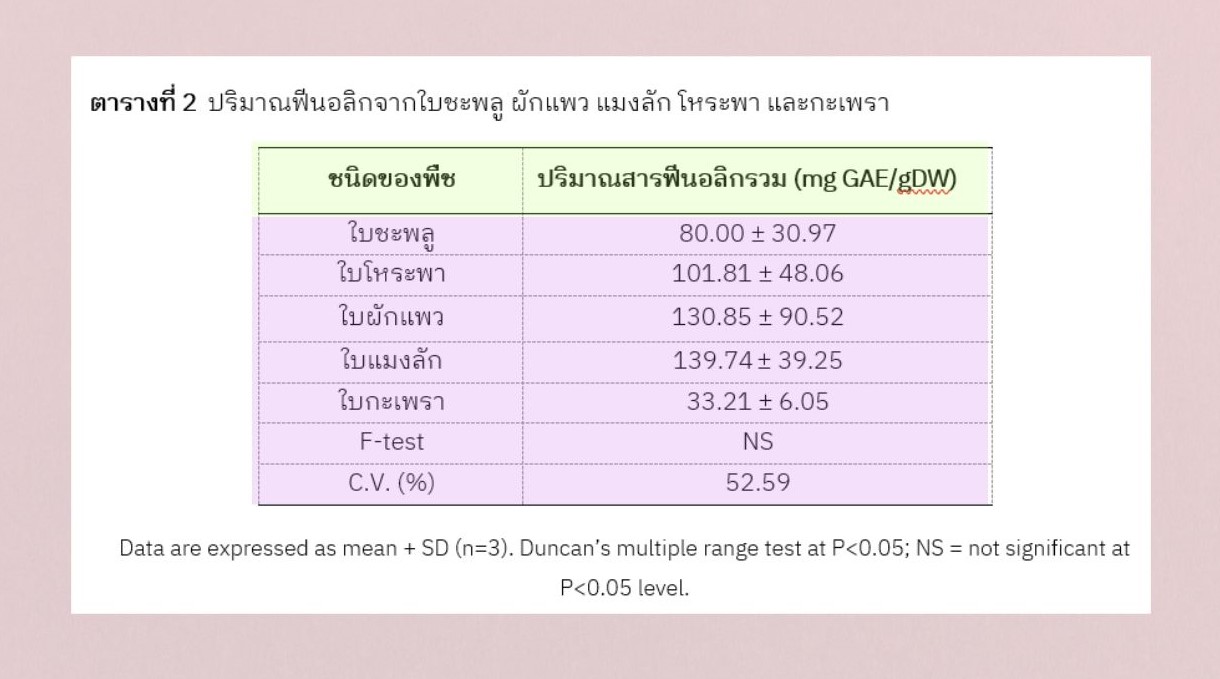ปริมาณสารฟีนอลิก ฟลาโวนอยด์ และความสามารถในการต้านอนุมูลอิสระของใบช้าพลู, ใบผักแพว, ใบแมงลัก, ใบโหระพา และ ใบกะเพรา
คำสำคัญ:
ต้านอนุมูลอิสระ, ฟีนอลิก, ฟลาโวนอยด์, ใบแมงลัก, สมุนไพรบทคัดย่อ
ใบชะพลู (Piper sarmentosum), ผักแพว (Polygonum odoratum, แมงลัก (Ocimum Americanum), โหระพา (Ocimum basilicum) และกะเพรา (Ocimum tenuiflorum) เป็นพืชผักสวนครัวในกลุ่มรสเผ็ดร้อน ส่วนสารฟีนอลิกและฟลาโวนอยด์ เป็นสารเมทาบอไลต์ทุติยภูมิของพืชที่มีประโยชน์ต่อร่างกายด้วยคุณสมบัติการต้านอนุมูลอิสระ โดยจะมีผลช่วยในการป้องกันการเกิดโรคเรื้อรังต่างๆ ในร่างกาย เช่น ความดันโลหิตสูง เบาหวาน เป็นต้น งานวิจัยนี้มีวัตถุประสงค์เพื่อเปรียบเทียบปริมาณ ฟีนอลิก ฟลาโวนอยด์ และความสามารถในการต้านอนุมูลอิสระของใบชะพลู โหระพา ผักแพว แมงลัก และกะเพรา ทำให้ได้ข้อมูลในการเลือกรับประทานเพื่อประโยชน์ต่อสุขภาพในเชิงการทานอาหารเป็นยาและเป็นข้อมูลสำหรับการเลือกใช้ในการพัฒนาไปเป็นผลิตภัณฑ์เสริมอาหารที่มีปริมาณสารออกฤทธิ์สารชีวภาพในกลุ่มของฟีนอลิกปริมาณสูงสุด วิเคราะห์ปริมาณฟีนอลิกด้วยวิธี Folin’s Ciocalteau reagent ปริมาณฟลาโวนอยด์วิเคราะห์ด้วยวิธี Aluminum chloride colorimetric method และความสามารถในการต้านอนุมูลอิสระด้วยวิธี DPPH radical scavenging activity โดยใช้ Gallic acid, Quercetin, Trolox เป็นสารมาตรฐาน ตามลำดับ พบว่า ใบแมงลัก มีปริมาณฟีนอลิก (139.74 mg GAE/gDW), ฟลาโวนอยด์ (411.40 mg QE/gDW) และความสามารถในการต้านอนุมูลอิสระ (37.27 %inhibition) ซึ่งมีปริมาณมากที่สุด นอกจากความอร่อยของอาหารแล้วคุณค่าที่ดีต่อสุขภาพก็เป็นอีกหนึ่งประเด็นที่สำคัญในการพิจารณาเลือกรับประทาน
เอกสารอ้างอิง
Azmi, N., Zulkurnain, E. I., Ramli, S., James, R. J., and Halim, H. (2021). The Phytochemical and Pharmacological Properties of Persicaria odorata: A Review. Journal of Pharmaceutical Research International, 33(41B): 262-279. http:// DOI: 10.9734/jpri/2021/v33i41B32366.
Butsat, S., & Siriamornpun, S. (2010). Antioxidant capacities and phenolic compounds of the husk, bran and endosperm of Thai rice. Food Chemistry, 119(2), 606-613. https://doi.org/10.1016/j.foodchem.2009.07.001
Kiraman, N. A. S. and Yusof, H. (2022). A mini review on the methods for the extraction, isolation, and determination of P. odorata's bioactive compounds. Healthscope, 5(2): 38-44. https://ir.uitm.edu.my/id/eprint/70596/1/70596.pdf.
Kunihiro, K., Kaneshima, T., Myoda, T. (2022). Antiglycative effect of extract and phenolic compounds from holy basil (Ocimum tenuiflorum). Glycative Stress Research, 9 (3): 175-185. https://www.toukastress.jp/webj/article/2022/GS22-33.pdf?20221025.
Mbegbu, N. N., Nwajinka, C. O., Amaefule, D. O. (2021). Thin Layer Drying Models and Characteristics of Scent Leaves (Ocimum Gratissimum) and Lemon Basil Leaves (Ocimum Africanum). Heliyon, 7(1): 1-9. https://doi.org/10.1016/j.heliyon.2021.e05945.
Omoikea, G. O., Georgea, B. O., Ugwua, E. O., and Okpoghono, J. (2022). Changes in the antioxidant properties of Ocimum africanum leaves aqueous extract from the southeastern region of Nigeria after in vitro gastrointestinal digestion. International Journal of Food Properties. 25(1): 2000-2008.https://www.tandfonline.com/doi/epdf/10.1080/10942912.2022.2120494?needAccess=true
Pawłowska, K.A., Strawa, J., Tomczyk, M., Granica, S. (2020). Changes in the phenolic contents and composition of Persicaria odorata fresh and dried leaves. Journal of Food Composition and Analysis, 19(103507). http:// DOI:10.1016/j.jfca.2020.103507.
Qin, W., Ketnawa, S., Ogawa, Y. (2021). Effect of Digestive Enzymes and pH on Variation of Bioavailability of Green Tea during Simulated in Vitro Gastrointestinal Digestion. Food Science and Human Wellness. 11(3): 669–675. http:// DOI:10.1016/j.fshw.2021.12.024.
Ridzuan, P., Hairul Aini, H., Mohd Hassan, N., Hairul Aini, H., Norazian, M. H., Shah, A., Aminah, K. S. (2013). Antibacterial and Antifungal Properties of persicaria odorata Leaf Against Pathogenic Bacteria and Fungi. In Proceedings Journal (Issue 4). https://www.researchgate.net/publication/348740094
Romano, R., Luca, L.De., Aiello, A., Pagano, R., Pierro, P.D.,Pizzolongo, F., & Masi, P. (2022). Basil (Ocimum basilicum L.) Leaves as a Source of Bioactive Compounds. Foods, 11(20): 1-13. http://doi:10.3390/foods11203212.
Shahrajabiana, M.H., Suna, W., Cheng, Q. (2020). Chemical components and pharmacological benefits of Basil (Ocimum basilicum): a review. International Journal of Food Properties, 23(1): 1961-1970. http:// DOI:10.1080/10942912.2020.1828456.
Silva, A. P. de. S, Camargo, A. C. de., Lazarini, J. G., Franchin, M., Sardi, J. de. C. O., Rosalen, P. L., and Alencar, S. M. de. (2023). Phenolic Profile and the Antioxidant, Anti-Inflammatory, and Antimicrobial Properties of Açaí (Euterpe oleracea) Meal: A Prospective Study., Foods, 12(86). https://doi.org/10.3390/foods12010086.
Sim, O. P., Rasid, A. R., Daud, N. H. A., David, D., Borhan, A. H., Saibeh, K., Silip, J. J., Milan, Abd. R., & Alimon, A. R. (2019). Preliminary Investigation on the Chemical Composition of Local Medicinal Herbs (Curcuma longa L., Persicaria odorata L. and Eleutherine palmifolia L.) as Potential Layer Feed Additives for the Production of Healthy Eggs. Transactions on Science and Technology, 6(2): 221– 227.https://tost.unise.org/pdfs/vol6/no2-2/6x2-2x221-227.pdf
Singh, D., Chaudhuri, P.K. (2018). A review on phytochemical and pharmacological properties of Holy basil (Ocimum sanctum L.). Industrial Crops and Products, 118: 367-382. http:// DOI:10.1016/j.indcrop.2018.03.048
Sultana, B., Anwar, F., & Ashraf, M. (2009). Effect of extraction solvent/technique on the antioxidant activity of selected medicinal plant extracts. Molecules, 14(6), 2167-2180.https://doi.org/10.3390/molecules14062167
Sun, X., Chen, W., Dai, W., Xin, H., Rahmand, K., Wang, Y., Zhang, J., Zhang, S., Xu, L., Han, T., (2020). Piper sarmentosum Roxb.: A review on its botany, traditional uses, phytochemistry, and pharmacological activities., Journal of Ethnopharmacology, 263 (112897). http:// DOI:10.1016/j.jep.2020.112897.
Ugwu, E. O., George, B. O., Omoike, G. O., Okpoghono, J. (2021). Bioaccessibility of Polyphenols and Flavonoids in Ocimum Africanum Leaves Extract. Uniport Journal of Engineering and Scientific Research. 6(1): 78–84. https://www.ujesr.org/images/vol6/Article-10.pdf.
Williams, W. B., Cuvelier, M. E., & Berset, C. (1995). Use of a free radical method to evaluate antioxidant activity. LWT-Food Science and Technology, 28(1), 25-30. https://doi.org/10.1016/S0023-6438(95)80008-5.

ดาวน์โหลด
เผยแพร่แล้ว
รูปแบบการอ้างอิง
ฉบับ
ประเภทบทความ
สัญญาอนุญาต
ลิขสิทธิ์ (c) 2024 วารสารสาธารณสุขและวิทยาศาสตร์สุขภาพ

อนุญาตภายใต้เงื่อนไข Creative Commons Attribution-NonCommercial-NoDerivatives 4.0 International License.
บทความทุกบทความที่ได้รับการตีพิมพ์ถือเป็นลิขสิทธิ์ของ วารสารสาธารณสุข















